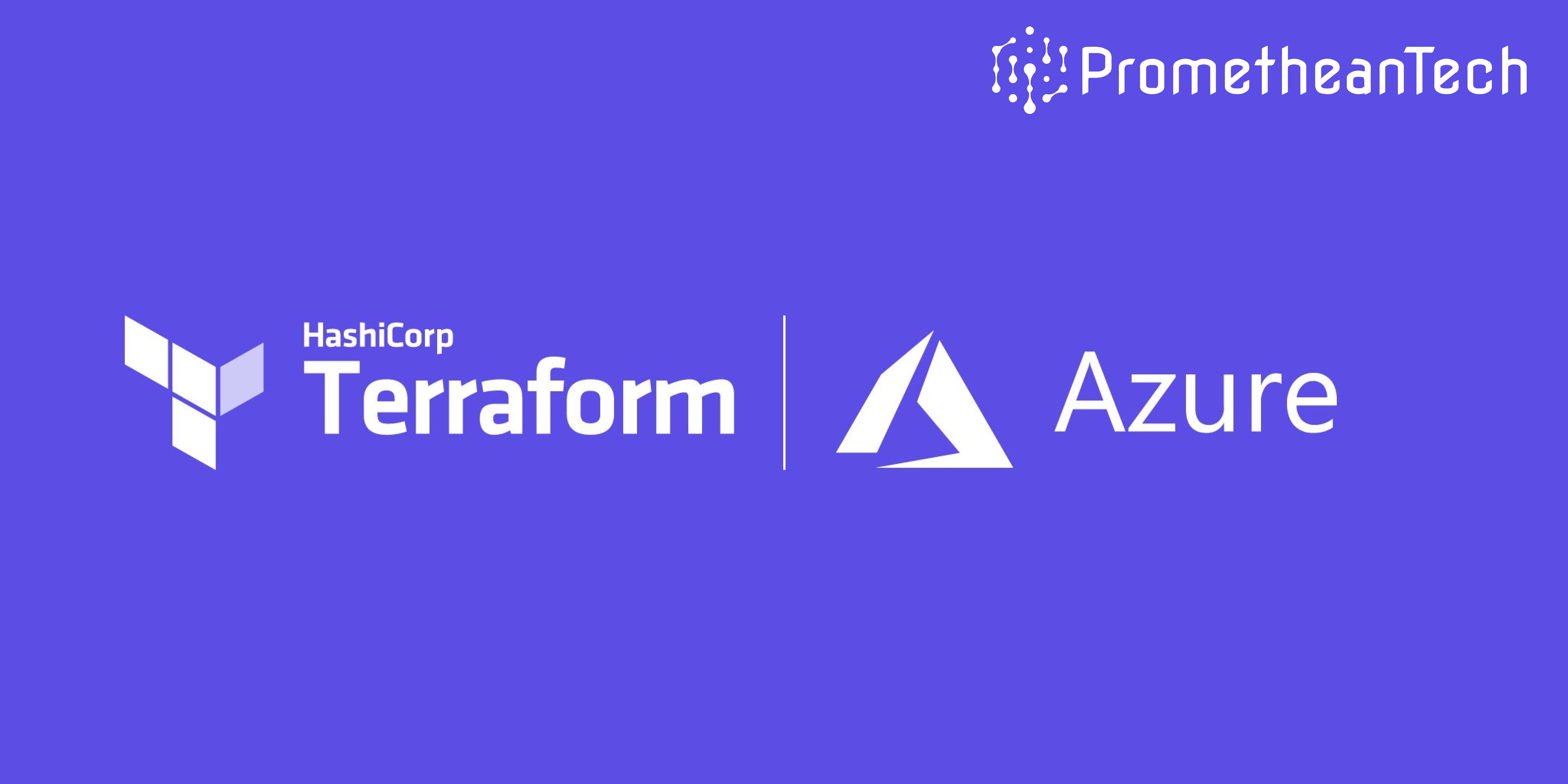Building Private Azure Infrastructure with Terraform: A Step-by-Step Guide


Building a Private Infrastructure on Azure with Terraform
In this blog, I'll guide you through the process of creating a secure, private infrastructure on Azure using Terraform. We will utilize custom modules to deploy various Azure services, ensuring that all components are privately accessible. This setup includes a private AKS cluster, ACR, private endpoints, and more. By the end, you'll have a robust and secure infrastructure ready for your applications.
Prerequisites
Before you begin, make sure you have the following installed:
Repository Structure
We have structured the repository using custom Terraform modules for each Azure service. This modular approach makes the infrastructure scalable and easier to manage. Clone the repository to get started:
git clone https://github.com/prometheantechws/Terraform-Azure-Infra.gitcd Terraform-Azure-Infra
Updating Configuration Files
Before running Terraform, you need to update the main.tf and terraform.tfvars files with your specific configurations.
-
main.tf: This is where we define the main structure of our infrastructure.
-
terraform.tfvars: This file contains variable definitions that Terraform will use during execution.
Make sure to change the values as per your requirements.
Custom Terraform Modules
Our infrastructure is built using the following custom modules:
- Resource Group (RG)
- Virtual Network (VNet)
- VNet Peering
- Private AKS Cluster
- Azure Container Registry (ACR)
- Private Endpoints
- Private DNS Zone
- Key Vault
- Virtual Machines (Linux and Windows)
- Storage Account
Each module is defined in the modules directory. Let's walk through the setup of each module.
Setting Up the Resource Group (RG)
The Resource Group is the container for all the resources in our Azure deployment.
module "RG" {source = "../../modules/RG"resource_group_name = var.resource_group_namelocation = var.location# tags = var.RG_tags}
Setting Up the Virtual Network (VNet)
The VNet will host our subnets for different services.
module "Vnet" {source = "../../modules/Vnet"resource_group_name = module.RG.RG_namelocation = var.locationdepends_on = [module.RG]vnets = var.virtual_networks}
VNet Peering
To allow communication between VNets.
module "vnet_peering" {source = "../../modules/Vnet-peering"depends_on = [module.Vnet]peerings = {peering1 = {name = var.peering_nameresource_group_name = module.RG.RG_namevnet1_name = module.Vnet.vnet_names["vnet1"]vnet2_id = module.Vnet.vnet_ids["vnet2"]vnet2_name = module.Vnet.vnet_names["vnet2"]vnet1_id = module.Vnet.vnet_ids["vnet1"]allow_forwarded_traffic = trueallow_gateway_transit = falseuse_remote_gateways = falseallow_virtual_network_access = true}}}
Private AKS Cluster
A private AKS cluster for running your Kubernetes workloads.
module "AKS" {source = "../../modules/AKS-Private-Cluster"depends_on = [module.RG,module.Vnet]aks_cluster_name = var.aks_cluster_nameresource_group_name = module.RG.RG_namelocation = var.locationdns_prefix = var.dns_prefixkubernetes_version = var.kubernetes_versiondefault_node_pool_name = var.default_node_pool_namenode_count = var.node_countvm_size = var.vm_sizeaks_vnet_subnet_id = data.azurerm_subnet.aks_subnet.iddefault_node_pool_auto_scaling = var.default_node_pool_auto_scalingdefault_node_pool_max_count = var.default_node_pool_max_countdefault_node_pool_min_count = var.default_node_pool_min_countdefault_node_pool_zones = var.default_node_pool_zonesidentity_type = var.identity_typesku_tier = var.sku_tiernetwork_plugin = var.network_pluginnetwork_policy = var.network_policyload_balancer_sku = var.load_balancer_skuoutbound_type = var.outbound_typedns_service_ip = var.dns_service_ipservice_cidr = var.service_cidrprivate_cluster_enabled = var.private_cluster_enabledrole_based_access_control_enabled = var.role_based_access_control_enabledspoke_vnet_id = module.Vnet.vnet_ids["vnet2"]spoke_subnet_id = module.Vnet.subnet_ids["vnet2"]["snet-aks-stage"]acr_id = module.ACR.acr_idkv_id = module.key_vault.kv_id############################# HUB VNET LINK #############################virtual_network_links = {link1 = {name = "vnetl-hub"virtual_network_id = module.Vnet.vnet_ids["vnet1"]registration_enabled = false}}#############################Private DNS ZONE#############################node_pools = {userpool-1 = {name = "npuserpool"vm_size = "Standard_E2as_v5"node_count = 1max_pods = 30mode = "User"os_disk_size_gb = 100os_type = "Linux"custom_ca_trust_enabled = falseenable_auto_scaling = trueenable_host_encryption = falseenable_node_public_ip = falsefips_enabled = falsemin_count = 1max_count = 3node_labels = {}node_taints = []vnet_subnet_id = data.azurerm_subnet.aks_subnet.idzones = ["1", "2", "3"]}}}
Azure Container Registry (ACR)
A private container registry for storing Docker images.
module "ACR" {source = "../../modules/Azure-Container-Registries"depends_on = [module.RG,module.Vnet]acr_name = var.acr_nameresource_group_name = module.RG.RG_namelocation = var.locationsku = var.skuadmin_enabled = var.admin_enabled}
Private Endpoints
Private Endpoints for secure connections.
module "acr_private_endpoints" {source = "../../modules/Azure-Private-Endpoints"depends_on = [module.RG,module.Vnet,module.ACR]resource_group_name = module.RG.RG_namelocation = var.locationvnet_name = module.Vnet.vnet_names["vnet1"]subnet_name = module.Vnet.subnet_names["vnet1"][1]private_endpoint_name = var.acr_private_endpoint_nameprivate_service_connections = {acr = {name = "acr-link"private_connection_resource_id = module.ACR.acr_idsubresource_names = ["registry"]is_manual_connection = false}}private_dns_zone_group_name = "private-dns-zone-group"private_dns_zone_ids = [module.acr_private_dns_zone.dns_zone_id]}
Private DNS Zone
For private DNS resolution.
module "acr_private_dns_zone" {source = "../../modules/Private-DNS-Zone"depends_on = [module.RG,module.Vnet]dns_zone_name = var.acr_dns_zone_nameresource_group_name = module.RG.RG_namevirtual_network_links = {link1 = {name = "pl-hub-vnet-link"virtual_network_id = module.Vnet.vnet_ids["vnet1"]registration_enabled = false}link2 = {name = "pl-spoke-vnet-link"virtual_network_id = module.Vnet.vnet_ids["vnet2"]registration_enabled = false}}}
Key Vault
A Key Vault for secure storage of secrets.
module "key_vault" {source = "../../modules/Key-Vaults"depends_on = [module.RG,module.Vnet]resource_group_name = module.RG.RG_namelocation = var.locationkey_vault_name = var.key_vault_namesku_name = var.key_vault_locationsoft_delete_retention_days = var.key_vault_soft_delete_retention_dayspurge_protection_enabled = var.key_vault_purge_protection_enabled# KV_ACCESS_POLICYkey_vault_dependency = [module.AKS]key_vault_id = module.key_vault.kv_idtenant_id = module.key_vault.kv_tenanet_idobject_id = module.AKS.aks_client_idkey_permissions = ["Get"]secret_permissions = ["Get"]certificate_permissions = ["Get"]}
Virtual Machines (Linux and Windows)
Deploying Linux and Windows VMs.
module "linux_vm" {source = "../../modules/Linux-Virtual-Machines"depends_on = [module.RG,module.Vnet]create_public_ip = falseresource_group_name = module.RG.RG_namelocation = var.locationvnet_name = module.Vnet.vnet_names["vnet1"]subnet_name = module.Vnet.subnet_names["vnet1"][0]vm_size = var.linux_vm_sizevm_admin_username = var.linux_vm_admin_usernamevm_admin_password = var.linux_vm_admin_passwordvm_name = var.linux_vm_namevm_type = var.linux_vm_type # or "Windows"subnet_id = module.Vnet.subnet_ids["vnet1"]["snet-shared-stage"]}module "windows_vm" {source = "../../modules/Windows-Virtual-Machines"resource_group_name = module.RG.RG_namelocation = var.locationvnet_name = module.Vnet.vnet_names["vnet1"]subnet_name = module.Vnet.subnet_names["vnet1"][0]vm_size = var.windows_vm_sizevm_admin_username = var.windows_vm_admin_usernamevm_admin_password = var.windows_vm_admin_passwordvm_name = var.windows_vm_namevm_type = var.windows_vm_type # or "Windows"subnet_id = module.Vnet.subnet_ids["vnet1"]["snet-shared-stage"]}
Storage Account
A storage account for data storage needs.
module "storage_account" {source = "../../modules/Storage-Accounts"depends_on = [module.RG,module.Vnet]resource_group_name = module.RG.RG_namelocation = var.locationstorage_account_name = var.storage_account_nameaccount_tier = var.account_tieraccount_replication_type = var.account_replication_typepublic_network_access_enabled = var.public_network_access_enabled}
Running Terraform
Once you have updated the configuration files with your details, run the following commands to deploy the infrastructure:
terraform initterraform validateterraform planterraform apply
Terraform will show you a plan of the resources it will create. Review the plan carefully and then apply it to create the resources.
Conclusion
In this blog, we set up a private infrastructure on Azure using Terraform and custom modules. This modular approach helps maintain clean and manageable code, making it easier to scale and manage the infrastructure.
Feel free to clone the repository and modify it as per your needs. Happy coding!
Contact Us
Thank you for reading our comprehensive guide on "Building Private Azure Infrastructure with Terraform" We hope you found it insightful and valuable. If you have any questions, need further assistance, or are looking for expert support in setting up and managing your Azure infrastructure, our team is here to help!
Reach out to us for Your Azure Infrastructure Needs:
🌐 Website: https://www.prometheanz.com
📧 Email: [email protected]
Happy Terraforming!
Copyright © 2024 PrometheanTech. All Rights Reserved.